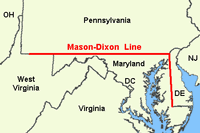This year marked the sesquicentennial of the end of the Civil War. With this sectarian conflict firmly 150 years behind us, one might think the divide itself (if not the conflict's effects) was firmly behind us as well. Yet it is still with us, and the Mason-Dixon Line is still in some ways a major cultural divider.
It is with us in quiet ways, like in the naming of events from the war: For instance, those in the North refer to the first major battle of the Civil War as the Battle of Bull Run; in the South, it is still known as the Battle of Manassas. Even the name of the war is mutable, still sometimes referred to in the South as the War of Secession or the War of Northern Aggression. The New York Times highlighted this still-divide in a piece in 2011, “Not Forgotten.”
This quiet divide became louder this past summer, during South Carolina’s battle over the Confederate flag waving over its Capitol. More than a century later, we cannot seem to escape the echoes—and partisanship—of this conflict.
As such, we as Philadelphians still, on some level, identify ourselves with The Union. We are Northerners, and we were on the side of fighting against slavery and secession. So as we read this year’s One Book, One Philadelphia, which takes place in North Carolina and focuses on a Confederate soldier, how do we feel? Can we empathize with Inman? Do we even want to?
Although this is set against a firmly southern landscape, it is not pro-Confederacy by any means. In the first chapter, Inman deserts the Confederate Army. We soon learn that he does not even truly support the war:
“How did he ever think this to be his country and worth fighting for? Ignorance alone would account for it. All he could list in his mind worth combat right now was his right to exist unmolested somewhere on the west fork of the Pigeon River drainage basin, up on Cold Mountain near the source of Scapecat Branch” (85).
His feelings are in line with many of the time, who were not fighting out of political or philosophical support, but rather because they were forced. The South introduced a draft in 1862, and after the passage of the Draft Act of 1863—the first instance of compulsory military service in the federal military—the North relied on a draft as well. This meant that many of those fighting had not chosen to enlist, and many perhaps had no ideological tie to the causes of their side.
We must also grapple with the fact that, despite our now 20/20 view that the North was “right,” Union soldiers could commit terrible acts. In Cold Mountain, travelers come upon Ada’s farm, recounting, “The Federals rode down on us and robbed even the niggers ... They took every bit of food we have been able to raise this year. … Then they burnt our house down in the rain and rode away. … We had nothing” (136). This passage complicates our view of the war and “our side.”
I believe we can still appreciate Cold Mountain as a work that offers a vivid account of war time and rich characters who grapple with its effects; yet still it gives a distinctly Southern—and white—view of the Civil War. It is for precisely this reason that we have chosen two companion books this One Book season to broaden the perspective and discussion on this time in our country. Twelve Years a Slave, by Solomon Northup, is the true-life account of a free black man kidnapped into slavery; The Civil War, by Geoffrey Ward with Ric Burns and Ken Burns, is a nonfiction expert overview of events precipitating the war, decisive battles and those who fought them, and emancipation.
Taken together, we hope these works will promote rich discussion throughout our region of this fundamental part of our national past—no matter which side of the line one sits on.
Have a question for Free Library staff? Please submit it to our Ask a Librarian page and receive a response within two business days.

